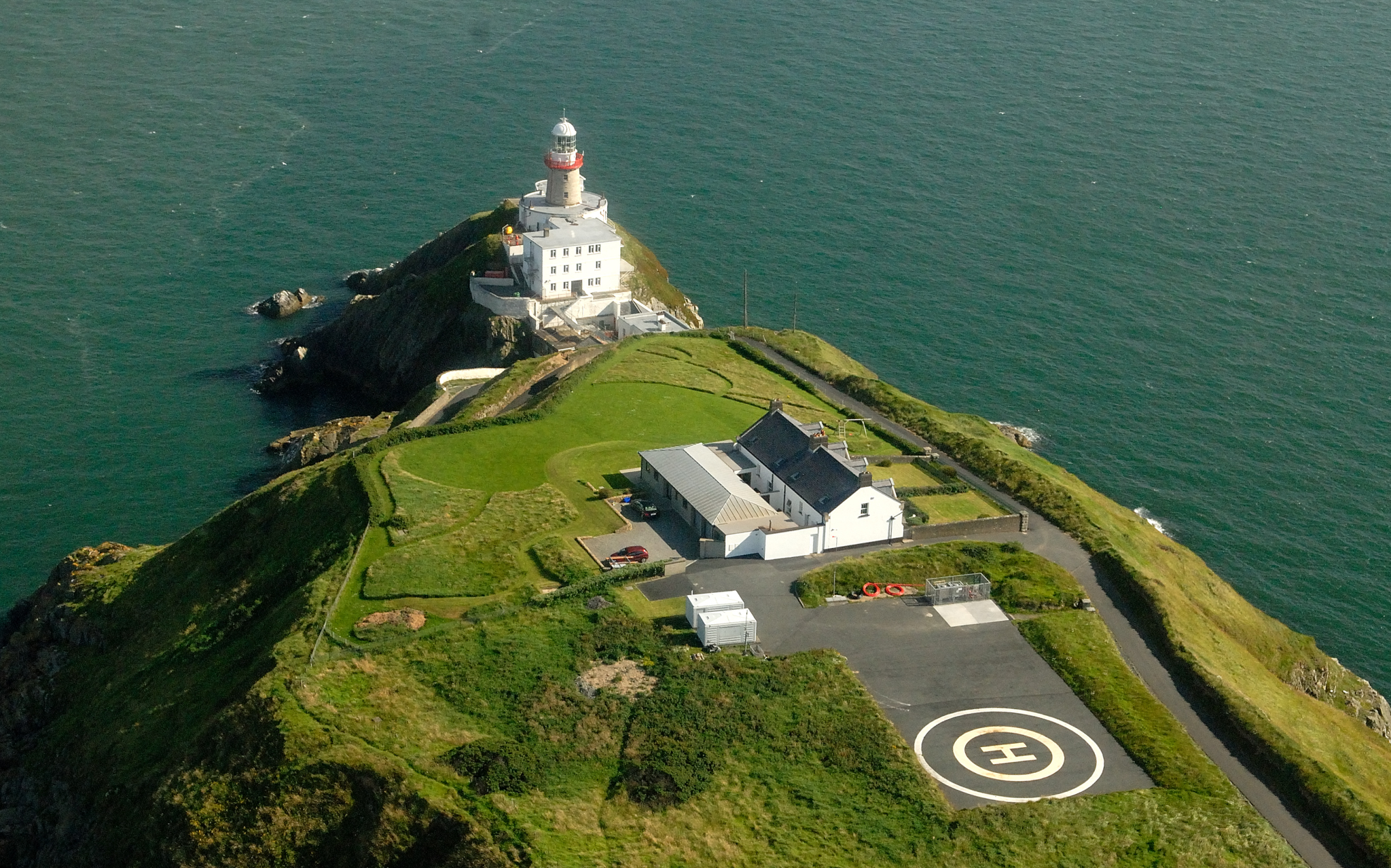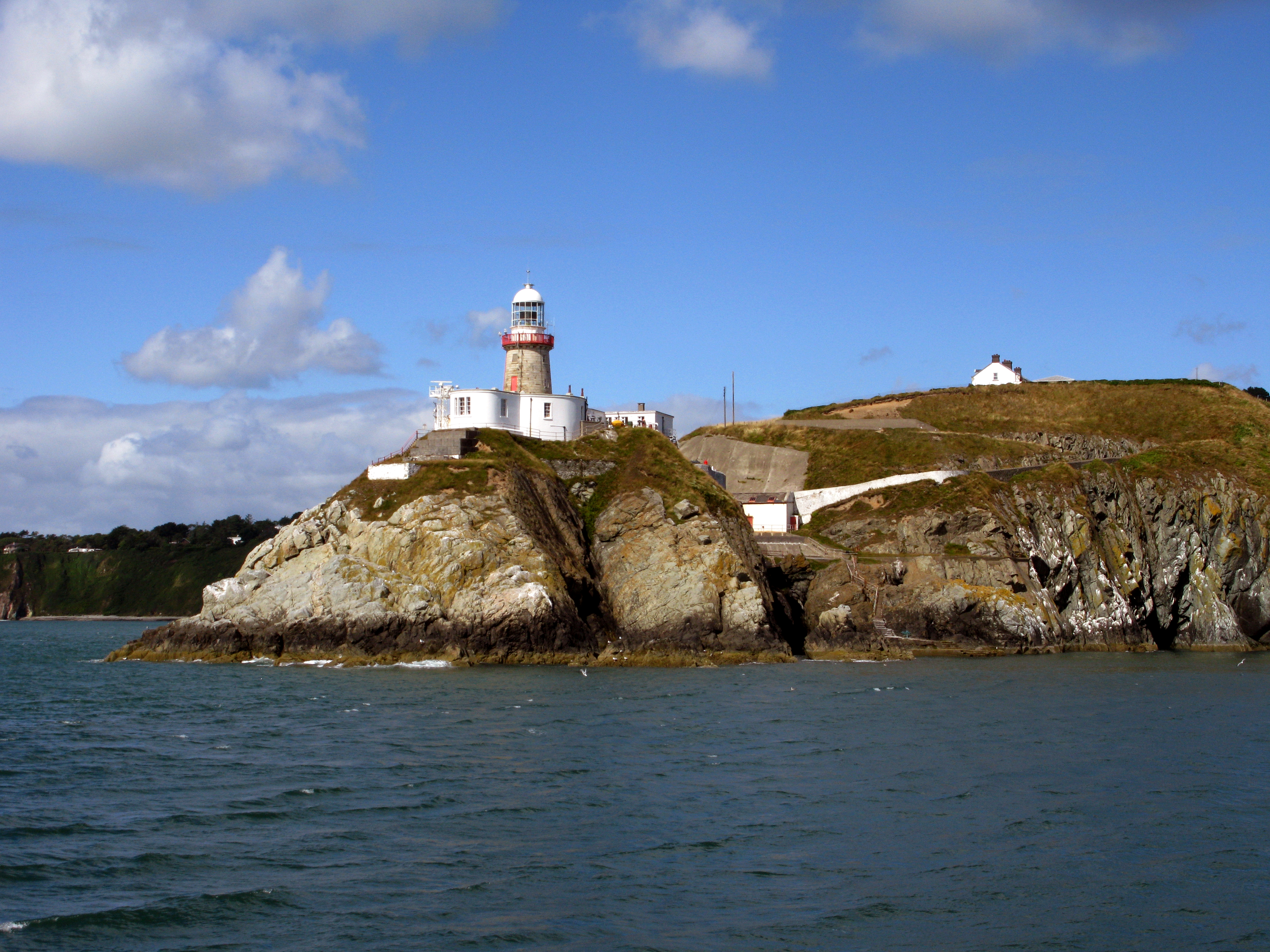Baily Lighthouse on:
[Wikipedia]
[Google]
[Amazon]



 The Baily Lighthouse (
The Baily Lighthouse (
 The optic which was in use from 1902 to 1972 is now on display in the
The optic which was in use from 1902 to 1972 is now on display in the
Commissioners of Irish Lights - Baily LighthouseBaily Lighthouse on the Travvi
{{authority control Lighthouses completed in 1814 Towers completed in 1814 Howth Lighthouses in the Republic of Ireland Lighthouses on the National Inventory of Architectural Heritage Buildings listed on the Fingal Record of Protected Structures


 The Baily Lighthouse (
The Baily Lighthouse (Irish
Irish may refer to:
Common meanings
* Someone or something of, from, or related to:
** Ireland, an island situated off the north-western coast of continental Europe
***Éire, Irish language name for the isle
** Northern Ireland, a constituent unit ...
: ''Teach Solais Dhún Criofainn'') is a lighthouse on the southeastern part of Howth Head
Howth Head ( ; ''Ceann Bhinn Éadair'' in Irish) is a peninsula northeast of the city of Dublin in Ireland, within the governance of Fingal County Council. Entry to the headland is at Sutton while the village of Howth and the harbour are o ...
in County Dublin
"Action to match our speech"
, image_map = Island_of_Ireland_location_map_Dublin.svg
, map_alt = map showing County Dublin as a small area of darker green on the east coast within the lighter green background of ...
, Ireland
Ireland ( ; ga, Éire ; Ulster Scots dialect, Ulster-Scots: ) is an island in the Atlantic Ocean, North Atlantic Ocean, in Northwestern Europe, north-western Europe. It is separated from Great Britain to its east by the North Channel (Grea ...
. It is maintained by the Commissioners of Irish Lights
The Commissioners of Irish Lights ( ga, Coimisinéirí Soilse na hÉireann), often shortened to Irish Lights or CIL, is the body that serves as the general lighthouse authority for Northern Ireland and the Republic of Ireland and their adjacen ...
.
History
Early history
The first lighthouse on this site was built in about 1667 by SirRobert Reading
Sir Robert Reading, first and last Baronet Reading, (c. 1640 – c. March 1689) built several privately owned lighthouses in Ireland under letters patent from Charles II of England.
He was educated at Christ Church, Oxford, receiving a BA i ...
, and was one of six that Reading had received letters patent to build from Charles II in 1665. The original facility consisted of a small cottage and a square tower which supported a coal-fired beacon. Parts of the original buildings remain. In 1790, the coal beacon was replaced with a set of six Argand oil lamps, each including a silvered copper parabolic and a bulls-eye glass pane. During this period, the lighthouse was maintained by the Revenue Commissioners.
New site
In 1810, the Corporation for Preserving and Improving the Port of Dublin took over the operations. The original building's location was high on the headland, so the light was often obscured by fog. On 5 December 1811 a recommendation was issued that the lighthouse be moved south on the headland to Little Baily, or Dungriffen. A new tower and house for the keeper, designed byGeorge Halpin
George Halpin (Sr.) (1779? – 8 July 1854), was a prominent civil engineer and lighthouse builder, responsible for the construction of much of the Port of Dublin, several of Dublin's bridges, and a number of lighthouses; he is considered the f ...
Senior, the corporation's Inspector of Works, was completed on 17 March 1814. The top of the tower stood 41 metres (134 ft) above the sea, and the fixed white catoptric
Catoptrics (from grc-gre, κατοπτρικός ''katoptrikós'', "specular", from grc-gre, κάτοπτρον ''katoptron'' "mirror") deals with the phenomena of reflected light and image-forming optical systems using mirrors. A catoptric ...
light was provided by a set of 24 Argand lamps and reflectors.
Shipwrecks
The area was the scene of a number of shipwrecks. On 3 August 1846 theCity of Dublin Steam Packet Company
The City of Dublin Steam Packet Company was a shipping line established in 1823. It served cross-channel routes between Britain and Ireland for over a century. For 70 of those years it transported the mail. It was 'wound-up' by a select commit ...
's paddle steamer
A paddle steamer is a steamship or steamboat powered by a steam engine that drives paddle wheels to propel the craft through the water. In antiquity, paddle wheelers followed the development of poles, oars and sails, where the first uses we ...
''Prince'' ran into the cliffs about 2½ km north of Baily in heavy fog, and as a result it was decided that fog bells should be installed at the lighthouse. This work was delayed due to costs of other construction projects.
The most notable wreck was the tragedy of the PS ''Queen Victoria'' on 15 February 1853, in which over 80 passengers and crew died. The fog bell was finally installed in April 1853, as a result of the ''Queen Victoria'' shipwreck and its subsequent Board of Trade inquiry.
Improvements
In 1865, the light source was improved from catoptric to first orderdioptric
Dioptrics is the branch of optics dealing with refraction, similarly the branch dealing with mirrors is known as catoptrics. Dioptrics is the study of the refraction of light, especially by lenses. Telescopes that create their image with an objec ...
. At the same time, John Richardson Wigham
:''This article concerns the Irish-based inventor and lighthouse engineer, not his cousin the shipbuilder John Wigham Richardson''.
John Richardson Wigham (15 January 1829 – 16 November 1906) was a prominent lighthouse engineer of the 19th cen ...
had patented a gas-burning light, so experiments with this new system were tried at Baily. A gas works was built at the station to produce the fuel, first from oil, then shale, and finally rich cannel coal. The experiments were a success, and the system was added to nine other lighthouses.
An air horn was installed in 1871 for times of fog, which was replaced with a siren in 1879. The bell was kept as a standby system until 1890. The siren was replaced by a diaphone
The diaphone is a noisemaking device best known for its use as a foghorn: It can produce deep, powerful tones, able to carry a long distance. Although they have fallen out of favor, diaphones were also used at some fire stations and in other situ ...
in 1926.
In 1892, two additional homes for Assistant Keepers were built. In 1902, a system was installed that caused the gas light to flash once every 30 seconds, instead of shining continually. In 1908, the gas light was replaced with one using incandescent vaporised paraffin. In 1953, a larger house was built for the Principal Keeper below the lighthouse.
Operations in modern times
In June 1972 the system was electrified, with a 1,500 watt bulb in a rotating lens, producing a flash every 20 seconds that can be seen at a range of . In 1973, additional dwellings for Supernumerary Assistant Lighthouse Keepers were built, as the Baily lighthouse became a training facility for Supernumerary Assistant Lighthouse Keepers who would then transfer to other lighthouses. Modern technology made light a secondary warning system, and a radio beacon became the primary method of warning ships. Starting in 1978, the light was operated only in poor visibility, along with the fog signal. The fog signal was finally discontinued in 1995. In late 1996, the lighthouse was converted to automatic operation, and the last of the Keepers left on 24 March 1997, making Baily the last Irish lighthouse to go automatic. The radio beacon service was discontinued in 1999, and at the same time, radar and additional communications equipment was installed. Although officially an automatic station, an attendant still lives in the Principal Keeper's residence. Part of the original lighthouse structure and the adjoining buildings have now been reconditioned as offices for D4H Technologies which appropriately provide software for the readiness, response and re-evaluation of emergencies and incidents worldwide.Museum
 The optic which was in use from 1902 to 1972 is now on display in the
The optic which was in use from 1902 to 1972 is now on display in the National Maritime Museum of Ireland
The National Maritime Museum of Ireland ( ga, Músaem Mhuirí Náisiúnta na hÉireann) opened in 1978 in the former Mariners' Church in Moran Park, located between the seafront and the centre of Dún Laoghaire town, southeast of Dublin city. ...
.
In 2000, a small museum was established in the reworked buildings by the Commissioners of Irish Lights, including small artefacts gathered from retired staff. This museum is not open routinely but by arrangement for staff and former staff, and their families, and small interest groups.
In Literature
The preservation of shipping afforded by this lighthouse is reflected on inLetitia Elizabeth Landon
Letitia Elizabeth Landon (14 August 1802 – 15 October 1838) was an English poet and novelist, better known by her initials L.E.L.
The writings of Landon are transitional between Romanticism and the Victorian Age. Her first major breakthrough ...
's 1834 poem, ''Howth Light-House''.
See also
*Lighthouses in Ireland
This is a list of lighthouses in Ireland. The Commissioners of Irish Lights are responsible for the majority of marine navigation aids around the island though a small number are maintained by local harbour authorities. The main list identifie ...
References
External links
Commissioners of Irish Lights - Baily Lighthouse
{{authority control Lighthouses completed in 1814 Towers completed in 1814 Howth Lighthouses in the Republic of Ireland Lighthouses on the National Inventory of Architectural Heritage Buildings listed on the Fingal Record of Protected Structures